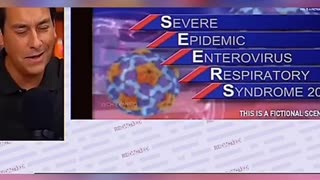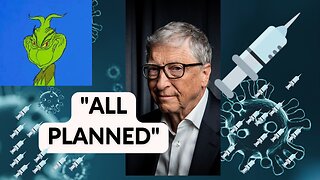How to Prevent the Next Pandemic by Bill Gates A Dalek Precis
Welcome to the Dalek Channel, where we love you for your mind.
Today we are pleased to present a precis of William Gates book, “How to prevent the next pandemic.”
=========================
This is not a criticism or an endorsement,
merely an attempt at an abbreviation.
=========================
Infectious diseases—both the kind that turn into pandemics and the kind that don’t—are something of an obsession for me. Unlike the subjects of my previous books, software and climate change, deadly infectious diseases are not generally something that people want to think about. (COVID-19 is the exception that proves the rule.) I’ve had to learn to temper my enthusiasm for talking about AIDS treatments and a malaria vaccine at parties.
My passion for the subject goes back twenty-five years, to January 1997, when Melinda and I read an article in The New York Times by Nicholas Kristof. Nick reported that diarrhea was killing 3.1 million people every year, almost all of them children. We were shocked. Three million kids a year! How could that many children be dying from something that was, as far as we knew, little more than an uncomfortable inconvenience?
When you start reading up on infectious diseases, it isn’t long before you come to the subject of outbreaks, epidemics, and pandemics. The definitions for these terms are less strict than you may think. A good rule of thumb is that an outbreak is when a disease spikes in a local area, an epidemic is when an outbreak spreads more broadly within a country or region, and a pandemic is when an epidemic goes global, affecting more than one continent. And some diseases don’t come and go, but stay consistently in a specific location—those are known as endemic diseases. Malaria, for instance, is endemic to many equatorial regions. If COVID-19 never goes away completely, it’ll be classified as an endemic disease.
In other words, the problem was not that there was some system in place that didn’t work well enough. The problem was that there was hardly any system at all.
In 2015, I published a paper in The New England Journal of Medicine, pointing out how unprepared the world was and laying out what it would take to get ready. I adapted the warning for a TED talk called “The Next Epidemic? We’re Not Ready,” complete with an animation showing 30 million people dying from a flu as infectious as the 1918 one. I wanted to be alarming to make sure the world got ready—I pointed out that there would be trillions of dollars of economic losses and massive disruption. This TED talk has been viewed 43 million times, but 95 percent of those views have come since the COVID pandemic started.
In March 2020, I had my first call with Anthony Fauci, the head of the infectious diseases institute of the National Institutes of Health. I’m lucky to have known Tony for years (long before he was on the cover of pop-culture magazines), and I wanted to hear what he was thinking about all this—especially the potential for various vaccines and treatments that were being developed.
Years ago, the eminent epidemiologist Dr. Larry Brilliant coined a memorable phrase: “Outbreaks are inevitable, but pandemics are optional.”
I know this sounds odd, but my favorite website is a treasure trove of data that tracks diseases and health problems all over the world. It’s called the Global Burden of Disease, and the level of detail it contains is astonishing. (The 2019 version tracked 286 causes of death and 369 types of diseases and injuries in 204 countries and territories.) If you’re interested in how long people live, what makes them sick, and how these things change over time, this site is the best source. I can spend hours at a time looking at the data.
What you really look for in a measure of success is a number that captures the overall impact of the disease. People who die of heart attacks because the hospital is too overwhelmed by COVID patients to treat them ought to be counted just as much as people who die of the disease itself.
There’s a measure that does exactly that: It’s called excess mortality, and it includes people who die because of the disease’s ripple effect as well as those who die directly from COVID.
Another example: The data suggests that cross-border trucking was responsible for a fair amount of spread from one country to another. So which places managed it well?
The White House’s response in 2020 was disastrous. The president and his senior aides downplayed the pandemic and gave the public terrible advice. Incredibly, federal agencies refused to share data with one another.
It certainly didn’t help that the director of the Centers for Disease Control and Prevention is a political appointee subject to political pressure, and some of the CDC’s public guidance was clearly influenced by politics.
Another relatively new approach is to go looking for signals in the environment. Many pathogens, including poliovirus and coronaviruses, show up in human feces, so you can detect them in the sewage system. Workers take samples of wastewater from treatment plants or open sewers and bring them to a lab, where they’re checked for these viruses.
Creating a PCR test for a new pathogen is a pretty easy task once you’ve sequenced its genome. Because you already know what its genes look like, you can create the special substances, dye, and other necessary products very quickly—which is why researchers were able to establish PCR tests for COVID just twelve days after the first genome sequences were published.
The one I’m most enthusiastic about comes from the British company LumiraDx, which is developing machines that test for multiple diseases and are so easy to operate that they don’t have to be limited to laboratories—they can be used in pharmacies, schools, and other settings.
In March 2020, the flu study group teamed up with the public health agency in King County, where Seattle is located, to create the Seattle Coronavirus Assessment Network, or SCAN. The pioneering system they had set up for gathering and processing flu samples and informing people of their results would be put to a new use: testing as many people for COVID as they could, mapping the results, and adding to the world’s collection of genetic sequencing for this brand-new pathogen.
There are some innovations coming in genomic sequencing equipment that will help a lot. For example, Oxford Nanopore, a spinoff from Oxford University, has developed a portable gene sequencer that eliminates the need for a full laboratory. It does require an online computer with a powerful processor, but some researchers from Australia and Sri Lanka are working on solving that problem too: They created an app that allows the information from the sequencer to be processed offline, on a standard-issue smartphone.
To get an idea of what modelers do when they’re trying to predict pandemic patterns, think about forecasting the weather. Meteorologists have models that are pretty good at predicting whether it will rain tonight or tomorrow morning. It was computer modeling that showed, early on, that even if only 0.2 percent of the population got infected with COVID, hospitals would be overflowing with patients in no time.
One step is to invest in all the elements of a robust health system that make it possible to detect and report diseases, as well as treat them.
Another step is to expand on efforts to understand the causes of death in adults and children alike.
Third, we need to know the enemy we’re up against. So governments and funders should back innovative ways to test mass numbers of people in a short time—especially high-volume, low-cost tests designed to work in low- and middle-income countries.
Finally, we need to invest in the promise of computer modeling.
I’m confused about what to do when I meet someone these days. Should we bump fists, shake hands, or just smile and wave? Depending on the nature of our relationship, I might want a combined handshake-and-hug, particularly if we haven’t seen each other for months.
In her book On Immunity, Eula Biss looks at vaccine hesitancy in a way that I think also helps explain the resentment we’re seeing toward other public health measures. The distrust of science is just one factor, she says, and it is compounded by other things that trigger fear and suspicion: pharmaceutical companies, big government, elites, the medical establishment, male authority.
Part of the problem is that it’s quite difficult to assess the impact of many of these measures—which are broadly called “non-pharmaceutical interventions,” or NPIs—in a controlled environment.
“If it looks like you’re overreacting, you’re probably doing the right thing.” That’s a quote from Tony Fauci, and I agree.
One study found that if Sweden’s neighbors had followed its lead instead of locking down stringently, Denmark would have had three times as many deaths as it did during the first wave, and Norway nine times as many as it did. Another study estimated that NPIs in six large countries, including the United States, prevented nearly half a billion COVID infections in the first few months of 2020 alone.
Also, not all overreactions—or apparent overreactions—are created equal. Closing borders, for example, did slow the spread of COVID in some regions. But border closures are a hammer that needs to be wielded very carefully. By cutting off trade and tourism, they can crater a country’s economy so badly that the cure becomes worse than the disease. This is particularly true if, as is often the case, the border controls come too late.
The pandemic also exposed one of the biggest myths about remote education—that it could ever replace classroom work for kids in the early grades. I’m a big fan of online learning, but I have always thought of it as a supplement to, not a substitute for, the work that young students and teachers do together in person.
On the other hand, it is clear to me that locking down assisted living homes for older people was the right thing to do. It saved a lot of lives because the virus is so much deadlier for the elderly—and I say this knowing how deeply painful and lonely these lockdowns were for all the residents who were confined to their rooms, and for their loved ones. It was heartbreaking to hear stories about families who had to say goodbye to a dying parent or grandparent through a closed window or over the phone.
What this all means is that there is no single ideal mix of NPIs that works equally well everywhere. Context matters, and protective measures need to be tailored for the places where they’ll be used.
But there was not a bad flu season that year. In fact, there was hardly any flu season at all. Between the flu seasons of 2019–20 and 2020–21, cases dropped 99 percent. As of late 2021, one particular type of flu known as B/Yamagata had not been detected anywhere in the world since April 2020. Other respiratory viruses also dropped dramatically.
Contact tracing works best in countries that excel at testing and processing data—among them, South Korea and Vietnam. But both of those countries did things that wouldn’t fly in the United States. Under a law changed after the 2014 outbreak of Middle East Respiratory Syndrome, or MERS, the South Korean government used data from credit cards, mobile phones, and surveillance cameras to trace the movements of infected people and identify other people they had come in contact with. It published this information online, though it had to restrict some of the data after regional governments gave out too many details about people’s movements. According to the journal Nature, one man “was wrongly accused of having an affair with his sister-in-law because their overlapping maps revealed they dined together at a restaurant.”
But contact tracing will often be an important part of stopping the spread of a disease, which is why we have to figure out how to build trust between public health agencies and the public so that more people will share their contacts.
Whenever you talk, laugh, cough, sing, or simply breathe out, you exhale. These globs are grouped into two categories by size: The larger ones are known as droplets, and the smaller ones are called aerosols.
The dividing line between them is typically 5 micrometers, which is roughly the size of the average bacterium. Anything bigger than that is a droplet, and anything smaller is an aerosol.
Droplets, being on the larger side, typically contain more virus than an aerosol, which makes them a better mechanism for transmission. On the other hand, because they’re relatively heavy, they don’t make it more than a few feet from your mouth or nose before falling to the ground.
The surface that a droplet lands on becomes what’s called a fomite, and how long the fomite is able to transmit the virus depends on several factors, including the type of pathogen and whether you sneezed or coughed it out (in which case it’s more protected because it’s covered in your mucus. In fact, even if someone does happen to touch a fomite, the chances that the person will get infected are less than 1 in 10,000.
In the meantime, the six-foot rule is a good one to follow, unless it’s very difficult to maintain, such as in a classroom. People need clear, easily remembered guidelines.
For many people who were following the research—people in the United States, at least—the argument in favor of masks was settled by an incident involving two hairstylists at a salon in Springfield, Missouri.
Both stylists developed symptoms and tested positive for COVID in May 2020. Their records indicated that they had exposed 139 clients. But everyone had masked up during the haircuts, and not a single client developed symptoms.
As a public health expert told me over dinner one night, “If everyone would just wear masks, How to Prevent the Next Pandemic would be a very short book.”
In March 2020, I went to an in-person meeting while I was feeling under the weather. Because the CDC hadn’t recommended masks yet, I didn’t wear one. Luckily, I later found out that I’d had the flu and not COVID, but I feel bad that I was there with respiratory symptoms without taking a measure that might have reduced the chance of spread.
Early on, rumors and misinformation about COVID seemed to be spreading faster than the disease itself.
Some of them are legitimate medical interventions: Hydroxychloroquine is used to treat malaria, lupus, and other diseases, and ivermectin is a standard treatment for various parasitic diseases in people and other animals. Obviously, just because a drug treats one condition doesn’t mean it will work on COVID, but it’s not irrational to hope that it might.
Doctors began prescribing hydroxychloroquine off-label—that is, for something other than its approved purpose—almost from Day 1. As far as treating COVID goes, the drug was a dead end.
Dexamethasone was a significant success: It was effective, easy to deliver, cheaper than any of the alternatives, and widely available even in many developing countries.
Merck and its partners developed a new antiviral called molnupiravir, which could be taken orally and was shown to significantly reduce the risk of hospitalization or death for people at high risk. In fact, the drug worked well enough that the clinical trial was stopped early.
Soon the study of a second oral antiviral, Paxlovid (made by Pfizer), was also stopped because the drug worked so well.
It’s a mistake to think of vaccines as the star of the show and therapeutics as the opening act you would just as soon skip.
A recurring theme of this book is that we don’t have to choose between preventing pandemics and improving global health more broadly—they reinforce each other.
In a process known as high-throughput screening, robotic machines can run hundreds of experiments at a time, mixing compounds and proteins and then using various methods to measure the reaction.
Regardless of the method involved, once a promising compound is identified, the scientific teams will analyze it to determine whether it’s worth further exploration. Once they’ve found a promising candidate in the exploratory phase, they will spend a year or two in the preclinical phase, studying whether the candidate is safe at effective doses and whether it actually triggers the expected response in animals.
If all goes well in the preclinical phase, we’ll move into the riskiest and most expensive part of the process: clinical trials in humans.
Now, this is how it works in nonpandemic times. In the emergency that COVID was, it needed to happen much, much faster.
One of the few trials that was handled well was the RECOVERY trial in the U.K., which looked at a number of drugs, including dexamethasone: It was ready to go within six weeks and included 40,000 participants at 185 sites.
Of course, the generic-drug business has downsides. As they headed for low prices and their profit margins narrowed, a few generic producers haven’t maintained the quality of their products the way they should have. But those are the outliers, and it’s hard to overstate the positive impact of low-cost, high-quality, high-volume generic manufacturers.
The fact that scientists were able to create multiple successful COVID vaccines is itself unusual in the history of disease. The fact that they did it in roughly a year is miraculous. It took scientists only one year to create safe and effective vaccines for the virus.
The first trial for an HIV vaccine began in 1987, and we still don’t have one that’s licensed. Before COVID, the land speed record for developing a vaccine was four years.
Getting a vaccine out of the lab and into recipients takes four steps—developing it, getting it approved, manufacturing it at high volumes, and delivering it.
In fact, the dozens of complex experiments that a company has to develop in order to ensure consistency contribute significantly to the ultimate cost of a dose. Unfortunately, several promising COVID vaccines have been seriously delayed because of such matters—this is not an area where it’s okay to cut corners.
Today’s COVID vaccines teach your immune system to attack part of the spike protein on the surface of one specific coronavirus. But researchers are now working on vaccines that would target shapes that show up on all coronaviruses, including COVID and its cousins, and would even be likely to appear on ones that evolve in the future.
It is hard to overstate the impact that mRNA vaccines have had on COVID. In many places, they account for virtually all of the COVID vaccinations. As of late 2021, more than 83 percent of vaccinated people in the European Union had received a vaccine made by either Pfizer or Moderna, both of which use mRNA. In the U.S., 96 percent had. Japan used only mRNA vaccines.
Before COVID, the only licensed viral-vectored vaccines were for Ebola, and those took five years to be approved.
Every vaccine that got emergency approval by the WHO was tested for safety in thousands of people around the world. In fact, because COVID vaccines have been given to so many people and their safety records tracked so closely, scientists now have extensive safety data on the various ones on the market—even in groups like pregnant women, who are usually not prioritized in clinical trials for vaccines because of the potential side effects for the babies they’re carrying.
Remember that many drugs are made using chemical processes that are well defined and measurable, but many vaccines don’t work that way. Manufacturing them often involves living organisms—anything from bacteria to chicken eggs. This is why we have generic drugs but not generic vaccines.
And if they were cheap and long-lasting enough—a few pennies for a dose that lasts thirty days or more—it might make sense to use them to block seasonal respiratory infections. Every schoolchild could get a dose at the beginning of each month. You could even set up sniffing stations where people would stop by every few weeks for another dose.
Because we can’t assume we’ll be so lucky next time—and because there are phenomenal opportunities for saving lives beyond the threat of pandemics—the world should be pursuing an ambitious agenda to make vaccines even better.
I see six areas that should be priorities for funding and research:
Universal vaccines. One and done, Total protection, No more ice chests,
So easy, anyone can give it, Expanded manufacturing.
For example, the United Kingdom ran an exercise called Winter Willow in 2007 and another, Cygnus, in 2016, both focused on flu outbreaks. Cygnus in particular highlighted problems with the government’s readiness and produced a series of classified recommendations that went unheeded—and which caused a scandal when The Guardian revealed them during the first year of the COVID pandemic.
For as long as I’ve been learning about pandemic preparedness and prevention, I’ve been amazed that there isn’t an ongoing series of full-scale exercises designed to test the world’s ability to detect and respond to an outbreak.
The United States had a similar experience in 2019, when the government ran Crimson Contagion, a series of exercises designed to answer one question: Was the country ready to respond to an outbreak of a novel flu virus? The scope of Crimson Contagion’s functional exercise was enormous. It involved 19 federal departments and agencies, 12 states, 15 tribal nations and pueblos, 74 local health departments, 87 hospitals, and more than 100 groups from the private sector.
The GERM team’s most important role will be to distill the findings from exercises and other measures of preparedness, record the recommendations that come out of them—ways to strengthen supply chains, better methods for coordinating across governments, agreements to improve the distribution of medicines and other supplies—and then try to keep the pressure on world leaders to translate these findings into action.
A good model of a simulation is a full-scale exercise developed by Vietnam in August 2018, designed to see how well the system identified a potentially worrisome pathogen.
The exercise didn’t go off flawlessly—the organizers noticed a number of gaps in the process—but it would be surprising if it had been flawless. The point is that the gaps were identified and, most important, fixed.
But there is another, even more unsettling scenario that disease exercises must account for—a pathogen that’s intentionally deployed with the goal of killing or maiming huge numbers of people. In other words, bioterrorism.
A new pathogen could be designed that is highly communicable and lethal but doesn’t cause symptoms right away.
On the whole, the world’s response to COVID has been exceptional. In December 2019, no one had heard of the disease. Within eighteen months, multiple vaccines had been developed, proven safe and effective, and delivered to more than 3 billion people, or nearly 40 percent of the earth’s population. Humans have never responded faster or more effectively to a global disease. We accomplished in a year and a half something that normally takes half a decade or more.
During the past decade, malaria killed 4 million children in sub-Saharan Africa but fewer than 100 people in the United States.
To keep it simple, you can think of it as 20-10-5. In 1960, 20 percent of the world’s children died. In 1990, it was 10 percent. Today it’s less than 5 percent.
The drop in family size has led to a remarkable phenomenon: The world recently passed what Hans called “peak child”—that is, the number of children under five hit its maximum and is going down. The benefit? As the United Nations Population Fund explains on its website, “Smaller numbers of children per household generally lead to larger investments per child, more freedom for women to enter the formal workforce, and more household savings for old age. When this happens, the national economic payoff can be substantial.”
Building up a strong immunization program was a fantastic investment for India long before COVID came along, and when the virus did arrive, the investment paid off again.
Countries that had recently been running large polio campaigns—as both Pakistan and India had done—had another advantage: their national and regional emergency operations centers.
If you strengthen health systems, for example, you can expect to see improvements in malaria, child mortality, maternal health, and so on.
Based on what they know about the disease and its variants, many scientists now believe that by the summer of 2022 the world will be moving out of the acute phase of the pandemic. The number of deaths will be going down globally, thanks to the protection conferred by vaccines and by the natural immunity you get once you’ve had the virus.
With any luck, we will move to dealing with COVID as an endemic disease, the way we deal with seasonal flu.
We should not assume that the next pandemic threat will look exactly like COVID. It may not be so much worse for the elderly than it is for young people, or it may also spread by lingering on surfaces or through human feces. It may be more infectious, passing more easily from one person to another. Or it may be deadlier. Worst of all, it could be both deadlier and more infectious.
I see four priorities for a global plan to eradicate respiratory diseases and prevent pandemics.
1. Make and deliver better tools.
2. Build the GERM team.
3. Improve disease surveillance.
4. Strengthen health systems.
My own view is that the evidence is very strong that it jumped from an animal to a human and did not, as some people have argued, come from a research laboratory. I know some well-informed people who don’t think the evidence for this view is as solid as I do.
In addition, the world’s disparate disease surveillance systems need to be integrated so that public health officials can rapidly detect emerging and circulating respiratory viruses no matter where they emerge.
Each country needs a pandemic prevention czar with the mandate to establish a plan and then execute it to contain an outbreak. That person’s authority needs to include establishing rules for procuring and distributing essential supplies, as well as having access to data and modeling. The GERM team should play this role internationally.
If the world can manage to eliminate greenhouse gas emissions by 2050, as I think it can, the energy research supported by the U.S. and its peers will be one reason why.
More funding is necessary, but it’s not sufficient. Another key contribution will be to ease the path to approval for products without sacrificing safety.
The WHO is the only organization that can strengthen the requirements for governments to be more open about potential outbreaks within their borders. Member countries of the WHO can also hold one another accountable for doing so—while recognizing that there are incentives to do just the opposite.
When I started telling friends that I was working on a book about pandemics, I could see that they were a little surprised. Many of them had been nice enough to read the book on climate change I published in 2021, and although they were too polite to say it, they were clearly thinking, “How many more of these books are you going to write where you’re telling us about some big problem and a plan to solve it? We have to do climate. Now we’re doing pandemics and health. What else is there?”
Climate change and pandemics—including the possibility of an attack by bioterrorists—are the most likely existential threats for humans.
Get vaccinated when you can. And avoid the misinformation and disinformation that flood social media: Get your information regarding public health practices from reliable sources, such as the WHO, the CDC in the United States, and its equivalent in other countries.
-
 56:39
56:39
ND BEST Entertainment
1 year agoPreparing for the Next Pandemic with Bill Gates | Davos
226 -
 10:44
10:44
Pam Popper
1 year agoBill Gates and the Next Pandemic
4.86K33 -
 1:04
1:04
ESND NEWS
1 year agoBill Gates The Next Pandemic
15 -
 0:54
0:54
GgVv
1 year agoBill Gates next pandemic 2025
65 -
 1:55
1:55
FlatEarther46
11 months agoBill Gates says to prepare for the next pandemic
831 -
 2:34
2:34
FlatEarther46
1 year agoget ready for bill gates next plandemic
29 -
 0:39
0:39
Power of the Pulse
1 year agoBill Gates Pandemic 2
177 -
 37:40
37:40
Purple Soul
1 year agoBill Gates' Plan for Next Pandemic Quietly Chugs Along
28 -
 4:48
4:48
D33pKn0wl3dG3
1 year agoBILL GATES: "We have to make sure that we are ready because there will be another Pandemic."
8 -
 5:03
5:03
Random videos of several different topics
11 months agoBill Gates Is At It Again ‼️ Another Pandemic? 😞
11